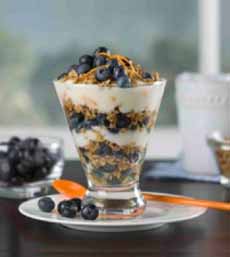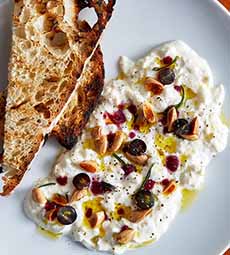|

[1] Add mozzarella balls to your salad or to fruit skewers (photo © Belgioioso).

[2] Yogurt parfait (photo © Fruits From Chile).

[3] Smoothies (photo © Sun Basket).

[4] Toast and ricotta with nuts, blueberries and a drop of EVOO. You can substitute raisins, dried cranberries, seeds, etc. (photo © Union Square Cafe).

[5] Salad with crumbled feta (those are burgundy carrots—photo © Molinari’s Restaurant | Facebook).

[6] Broccoli with bacon, toasted almonds and shaved parmesan. Here’s the recipe from McCormick.
|
|
June is National Dairy Month.
We love dairy products, and consume more than our fair share of milk, cheese and yogurt. But few people we know do the same.
Here’s some advice from Jean Ragalie-Carr RDN, LDN, FAND, president of the National Dairy Council and chair of the Academy of Nutrition and Dietetics Foundation.
WHY YOU SHOULD HAVE 3 DAIRY SERVINGS EACH DAY
The 2015 Dietary Guidelines for Americans recommends three daily servings of low-fat or fat-free dairy foods for everyone age 9 and up (two and a half servings for children aged 4-8, two servings for children aged 2-3).
There’s a good reason for these recommendations. Eating three daily servings of low-fat or fat-free milk, cheese or yogurt can help us meet our needs for essential nutrients.
Milk provides nine essential nutrients: protein, phosphorus, calcium, vitamins A and D as well as B2 (riboflavin), B3 (niacin), B5 (pantothenic acid) and B12 (cobalamin).
Yogurt provides seven essential nutrients: protein, phosphorus, calcium, zinc, B2 (riboflavin), B5 (pantothenic acid) and B12 (cobalamin).
Cheese provides six essential nutrients: protein, phosphorus, calcium, B3 (niacin), vitamin A and B12 (cobalamin).
Three daily servings of dairy also contribute three of the four under-consumed nutrients in American diets: calcium, vitamin D and potassium.
The fourth nutrient is fiber, which can be found in foods like fruits, vegetables, whole grains and beans. Coincidentally, each of these fiber foods pairs well with dairy.
HOW YOU BENEFIT
Three daily servings of low-fat or fat-free dairy foods, as part of a healthy eating pattern, is linked to bone health, especially in children and adolescents.
Adults benefit from reduced risk of cardiovascular disease, type 2 diabetes and high blood pressure.
Despite the benefits, unfortunately, most Americans are consuming just shy of two servings every day.
It’s easy to add that third serving. Dairy products are portable, accessible and affordable; and as you can see from the photos, delicious!
WAYS TO GET YOUR 3 DAILY DAIRY SERVINGS
You know that it’s easy to grab a yogurt, cottage cheese or other cheese, or a glass of milk (even chocolate milk).
Alas, regular cream cheese, cream and butter are not part of the dairy food group. They are high in saturated fat and have little or no calcium.
Instead, try these:
Breakfast on yogurt, berries and granola or other cereal; a yogurt parfait; or a smoothie bowl.
Enjoy string cheese with almonds and grapes.
Mix up a smoothie with yogurt, milk and frozen fruit.
Top salads, casseroles, soups or veggies with grated cheese.
Have a Caprese Salad: mozzarella, tomatoes and basil.
Mix a packet of onion or ranch dip with Greek yogurt or cottage cheese, and dip your favorite veggies or whole grain crackers into it.
Make pudding with low-fat milk and mix in extra whey protein powder. Serve it with fresh fruit.
Grab a cold glass of low-fat milk.
Warm up low-fat chocolate milk for hot chocolate.
Have a cheese veggie burger (ideally without the roll); or a cheese and raw veggie sandwich (with cucumber, lettuce, tomato and onion).
Turn roasted vegetables into a veggie grilled cheese (photo #4).
Spread cottage cheese or ricotta on toast or a bagel.
Choose cheese or cheese and fruit for snacks, instead of refined carbs.
Have a latte instead of coffee and milk.
WHAT IF YOU’RE LACTOSE INTOLERANT?
Lactose Free & High In Calcium
Fortified cereals such as Corn Flakes, Raisin Bran and Total have a lot of calcium per serving.
Fortified orange juice.
Lactose-free dairy: The Lactaid brand has cottage cheese, milk and sour cream (and ice cream, too).
Lactose-free dairy: The Green Valley brand (at Whole Foods and other specialty stores) has lactose-free sour cream and yogurt (and cream cheese, too).
Leafy greens: broccoli and rabe, collard greens, edamame (soy beans) kale, turnips, spinach.
Sardines are delicious, grilled fresh or canned in salads with feta and olives, etc.
Soybeans: cooked soybeans, edamame, soy milk, soy nuts, tempeh, tofu.
For Vegans
In addition to the vegan foods above, look for soymilk that has about 300 mg of calcium per serving. Not all soymilk is a good source of calcium, so check the label.
|





